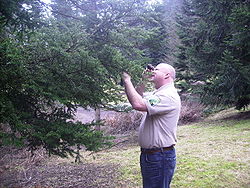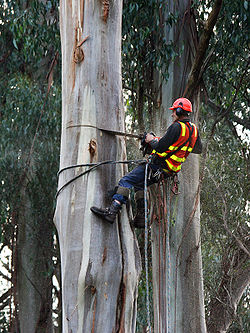
Arboriculture
Encyclopedia


The science of arboriculture studies how these plants grow and respond to cultural practices and to their environment. The practice of arboriculture includes cultural techniques such as selection, planting, training, fertilization, pest and pathogen
Pathogen
A pathogen gignomai "I give birth to") or infectious agent — colloquially, a germ — is a microbe or microorganism such as a virus, bacterium, prion, or fungus that causes disease in its animal or plant host...
control, pruning
Pruning
Pruning is a horticultural practice involving the selective removal of parts of a plant, such as branches, buds, or roots. Reasons to prune plants include deadwood removal, shaping , improving or maintaining health, reducing risk from falling branches, preparing nursery specimens for...
, shaping, and removal.
Risk management
Risk management
Risk management is the identification, assessment, and prioritization of risks followed by coordinated and economical application of resources to minimize, monitor, and control the probability and/or impact of unfortunate events or to maximize the realization of opportunities...
, legal issues, and aesthetic considerations have come to play prominent roles in the practice of arboriculture.
Arboriculture is primarily focused on individual woody plants and trees maintained for permanent landscape
Landscape
Landscape comprises the visible features of an area of land, including the physical elements of landforms such as mountains, hills, water bodies such as rivers, lakes, ponds and the sea, living elements of land cover including indigenous vegetation, human elements including different forms of...
and amenity
Amenity
In real property and lodging, amenities are any tangible or untangible benefits of a property, especially those that increase its attractiveness or value or that contribute to its comfort or convenience...
purposes, usually in gardens, parks or other populated settings, by arborists, for the enjoyment, protection, and benefit of human beings. It is therefore related to, but distinct from agriculture
Agriculture
Agriculture is the cultivation of animals, plants, fungi and other life forms for food, fiber, and other products used to sustain life. Agriculture was the key implement in the rise of sedentary human civilization, whereby farming of domesticated species created food surpluses that nurtured the...
, horticulture
Horticulture
Horticulture is the industry and science of plant cultivation including the process of preparing soil for the planting of seeds, tubers, or cuttings. Horticulturists work and conduct research in the disciplines of plant propagation and cultivation, crop production, plant breeding and genetic...
, urban forestry
Urban forestry
Urban forestry is the careful care and management of urban forests, i.e., tree populations in urban settings for the purpose of improving the urban environment. Urban forestry advocates the role of trees as a critical part of the urban infrastructure...
, forestry
Forestry
Forestry is the interdisciplinary profession embracing the science, art, and craft of creating, managing, using, and conserving forests and associated resources in a sustainable manner to meet desired goals, needs, and values for human benefit. Forestry is practiced in plantations and natural stands...
, dendrology
Dendrology
Dendrology or xylology is the science and study of wooded plants . There is no sharp boundary between plant taxonomy and dendrology. However, woody plants not only belong to many different plant families, but these families may be made up of both woody and non-woody members. Some families include...
, and silviculture
Silviculture
Silviculture is the practice of controlling the establishment, growth, composition, health, and quality of forests to meet diverse needs and values. The name comes from the Latin silvi- + culture...
.
See also
- ArboristArboristAn arborist, or arboriculturist, is a professional in the practice of arboriculture, which is the cultivation, management, and study of individual trees, shrubs, vines, and other perennial woody plants...
- BonsaiBonsaiis a Japanese art form using miniature trees grown in containers. Similar practices exist in other cultures, including the Chinese tradition of penjing from which the art originated, and the miniature living landscapes of Vietnamese hòn non bộ...
- European Arboricultural CouncilEuropean Arboricultural CouncilThe European Arboricultural Council based in Bad Honnef, Germany is a forum where delegates from a wide range of arboricultural organizations throughout Europe meet. The goal of the EAC is to elevate the status and to raise the professional level of competence within arboriculture...
- Fruit tree pruning
- HorticultureHorticultureHorticulture is the industry and science of plant cultivation including the process of preparing soil for the planting of seeds, tubers, or cuttings. Horticulturists work and conduct research in the disciplines of plant propagation and cultivation, crop production, plant breeding and genetic...
- Indigo Surveys
- International Society of ArboricultureInternational Society of ArboricultureThe International Society of Arboriculture is an international non-profit organization headquartered in Champaign, Illinois USA. Its mission statement: "Through research, technology, and education promote the professional practice of arboriculture and foster a greater public awareness of the...
- Landscape architectureLandscape architectureLandscape architecture is the design of outdoor and public spaces to achieve environmental, socio-behavioral, or aesthetic outcomes. It involves the systematic investigation of existing social, ecological, and geological conditions and processes in the landscape, and the design of interventions...
- LandscapingLandscapingLandscaping refers to any activity that modifies the visible features of an area of land, including:# living elements, such as flora or fauna; or what is commonly referred to as gardening, the art and craft of growing plants with a goal of creating a beautiful environment within the landscape.#...
- Tree shaping
- TrophortTrophortTropHort is an abbreviation for Tropical Horticulture. Tropical Horticulture is a branch of horticulture that studies and cultivates garden plants in the tropics, i.e., the equatorial regions of the world....
- Urban forestryUrban forestryUrban forestry is the careful care and management of urban forests, i.e., tree populations in urban settings for the purpose of improving the urban environment. Urban forestry advocates the role of trees as a critical part of the urban infrastructure...
- ViticultureViticultureViticulture is the science, production and study of grapes which deals with the series of events that occur in the vineyard. When the grapes are used for winemaking, it is also known as viniculture...
External links
- Arboricultural Association UK
- International Society of Arboriculture (USA)
- European Arboricultural Council
- BatsandTrees.com Promoting the importance of British trees to bats
- Institute of Chartered Foresters The UK based Chartered body for forestry and arboricultural professionals
- TreesAreGood.com (arboricultural resources for the general public)
- Tree information and facts, scientific aids for arborists
- Bartleby.com
- American Forests Urban forestry resources
- Bartlett Tree Expert Company Resource Documents Online resource library of arboricultural technical reports
- Encyclopædia Britannica
- Merriam-Webster Online
- eTreeRemoval.com

